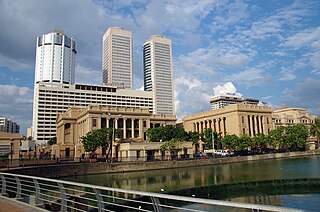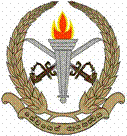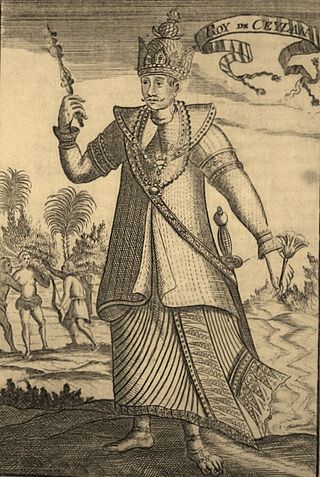
Colombo is the executive and judicial capital and largest city of Sri Lanka by population. According to the Brookings Institution, the Colombo metropolitan area has a population of 5.6 million, and 752,993 in the Municipality. It is the financial centre of the island and a tourist destination. It is located on the west coast of the island and adjacent to the Greater Colombo area which includes Sri Jayawardenepura Kotte, the legislative capital of Sri Lanka, and Dehiwala-Mount Lavinia. Colombo is often referred to as the capital since Sri Jayawardenepura Kotte is itself within the urban/suburban area of Colombo. It is also the administrative capital of the Western Province and the district capital of Colombo District. Colombo is a busy and vibrant city with a mixture of modern life, colonial buildings and monuments.

The Sri Lanka Railway Department is Sri Lanka's railway owner and primary operator. As part of the Sri Lankan government, it is overseen by the Ministry of Transport. Founded in 1858 as the Ceylon Government Railway, it operates the nation's railways and links Colombo with other population centres and tourist destinations.

The Sri Lanka Military Academy, commonly known simply as Diyatalawa, is the Sri Lanka Army's training centre where officer cadets are trained for getting commission. It is located in the garrison town of Diyatalawa in the central highlands of Sri Lanka. All Sri Lanka Army officer cadets, including army cadets of the General Sir John Kotelawala Defence University, are trained at SLMA. Although not a university, SLMA is affiliated to the General Sir John Kotelawala Defence University to provide its cadets of regular long course a degree in military studies.
Rajasinghe I was a king of Sitawaka, known for his patriotism and fight against the Portuguese invasion of Sri Lanka. Born as Tikiri Bandara to King Mayadunne, he received the name "Rajasimha" after the fierce Battle of Mulleriyawa.

Vimaladharmasūriya I was a king of Kandy from 1590 to 1604. His reputation was built when he successfully repulsed two major Portuguese offensives on Kandy, the Battle of Danture in 1594 and the Battle of Balana in 1602, in both of which the Portuguese were humiliatingly defeated.
Udarata Menike is a daytime passenger train that runs between Colombo and Badulla in Sri Lanka.
Forts and fortifications in Sri Lanka date back thousands of years with many being built by Sri Lankan Kings, these include several walled cities. With the out set of colonial rule in the Indian Ocean, Sri Lanka was occupied by several major colonial empires that from time-to-time became the dominant power in the Indian Ocean. The colonists built several western styled forts, mostly in and round the coast of the island. The first to build colonial forts in Sri Lanka were the Portuguese, these forts were captured and later expanded by the Dutch. The British occupied these Dutch forts during the Napoleonic wars.
Balana is a village in Sri Lanka. It is located within the Kandy District, Central Province.

Jaffna Fort is a fort built by the Portuguese at Jaffna, Sri Lanka in 1618 under Phillippe de Oliveira following the Portuguese invasion of Jaffna. The fort is located near the coastal village of Gurunagar. Due to numerous miracles attributed to the statue of Virgin Mary in the church nearby, the fort was named as Fortress of Our Lady of Miracles of Jafanapatão. It was captured by the Dutch under Rijcklof van Goens in 1658 who expanded it. In 1795, it was taken over by the British, and remained under the control of a British garrison till 1948. As the only large military fort in the country, due to the presence of only government and military buildings within its ramparts, it was garrisoned by a detachment of the Ceylon Army.
"Podi Manike" is a Sri Lankan passenger train running from Colombo Fort to Badulla. This journey covers about 300 km and is renowned for being the most beautiful train journey in Sri Lanka, especially the stretch from Nanuoya to Ella. It takes about 10 hours to complete the journey.

The Main Line is a major railway line in the rail network of Sri Lanka and considered by many to be one of the most scenic train journeys in all of Asia. The line begins at Colombo Fort and winds through the Sri Lankan hill country to reach Badulla.
The Danture campaign comprised a series of encounters between the Portuguese and the Kingdom of Kandy in 1594, part of the Sinhalese–Portuguese War. It is considered a turning point in the indigenous resistance to Portuguese expansion. For the first time in Sri Lanka a Portuguese army was essentially annihilated, when they were on the verge of the total conquest of the island. A 20,000-strong Portuguese army, led by Governor Pedro Lopes de Sousa, invaded Kandy on 5 July 1594. After three months, severely depleted by guerilla warfare and mass desertions, what remained of the Portuguese army was annihilated at Danture by the Kandyans under King Vimaladharmasuriya. With this victory, the Kingdom of Kandy emerged as a major military power; it was to retain its independence, against Portuguese, Dutch, and British armies, until 1815.
The Kandyan naval raid was a series of commerce raidings by the Kingdom of Kandy against the Portuguese empire from 16 May 1612 to 6 March 1613. With the help of Dutch envoy Marcellus de Bochouwer, King Senarat of Kandy commissioned a fleet of 3 war galleys and 3 yachts under the Admiralty of a nephew of Kuruvita Rala, the prince of Uva. They sailed from Koddiyar bay and managed to engage and inflict losses on Portuguese shipping around Ceylon and along the coast line from Cape Comorin to Calicut.

Sinhalese–Portuguese conflicts refers to the series of armed engagements that took place from 1518 to 1658 in Sri Lanka between the native Sinhalese kingdoms and the Portuguese Empire. It spanned from the Transitional to the Kandyan periods of Sri Lankan history. A combination of political and military moves gained the Portuguese control over most of the island, but their invasion of the final independent kingdom was a disaster, leading to a stalemate in the wider war and a truce from 1621. In 1638 the war restarted when the Dutch East India Company intervened in the conflict, initially as an ally of the Sinhalese against the Portuguese, but later as an enemy of both sides. The war concluded in 1658, with the Dutch in control of about half the island, the Kingdom of Kandy the other half, and the Portuguese expelled.

House of Siri Sanga Bo was a powerful dynasty which ruled parts of Sri Lanka from Vijayabahu III of Dambadeniya (1220–1224) until Rajasinha I of Sitawaka (1581–1591). Vijayabahu III of Dambadeniya routed Kalinga Magha's armies from Maya Rata and established his fortress at Dambadeniya. This dynasty was able to protect their independence by facing so many foreign invasions thereafter. They had to change their capital city to Dambadeniya, Yapahuwa and Kurunagala because of continuous invasions from southern India.

AlagallaMountain Range is situated at the boundaries of the Central and Sabaragamuwa Provinces in Sri Lanka. Along with the surrounding Bathalegala (බතලේගල) also known as Bible Rock, Uthuwankanda (උතුවන්කන්ද), Devanagala (දෙවනගල), Ambuluwawa (අම්බුළුවාව), Knuckles Mountain Range and Hanthana (හන්තාන) Mountain Range, Alagalla mountain has served as a natural defense location for nearly five centuries (1505–1948) against the Portuguese, Dutch and English invasions aimed at the Kandyan Kingdom.
Balana Fort was a fortified pass of the Kingdom of Kandy located near the Alagalla Mountain Range, Sri Lanka. Balana which means the 'look out' in Sinhala, functioned as a strategic outpost and fortress of the kingdom which was situated along the historical Colombo-Kandy road.

Kadugannawa Pass is a mountain pass located near Kadugannawa town in the Central Province of Sri Lanka. It is located along the Colombo-Kandy A1 highway. It is a common roadside stop for tourists to enjoy the vistas to the Kegalle valley below and view the prominent inselberg known as the Bible Rock.









